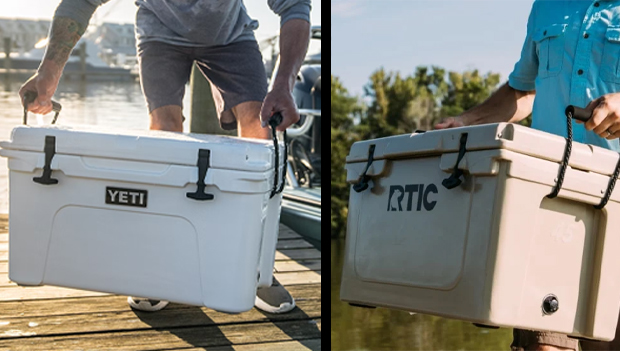
A cooler should be on everyone's list of the best camping gear. Unfortunately, not all coolers are created equal. Brands like Yeti and RTIC stand above the rest, but the debate over RTIC vs. Yeti can be heated at times.
The reality is that both of these companies make excellent coolers. Whether you're RV or truck camping or looking for the perfect gift for the avid angler in your life, a cooler from either of these brands is a smart choice.
Of course, RTIC and Yeti both make more than just standard hard coolers, they also make soft coolers, drinkware, and a variety of camping and lifestyle accessories that make great gifts for the holidays.
You don't have to spend big to get someone you love a quality gift from these brands, but you certainly can. And when it comes to keeping food fresh and beverages chilled when you're camping, we think spending a little more on a high-quality cooler is worth it.
But should you spend that money on RTIC or Yeti coolers? That's what we're here to investigate!
Why Trust Us?
ACTIVE.com's editorial team relies on the knowledge and experience of fitness and wellness experts including competitive athletes, coaches, physical therapists, nutritionists, and certified trainers. This helps us ensure that the products we feature are of the highest standard. Collectively, the team has spent countless hours researching equipment, gear, and recovery tools to create the most accurate, authentic content for our readers. Customer satisfaction is a key part of our review process, which is why we only feature products that are highly rated.
RTIC vs. Yeti
By clicking on the product links in this article, we may receive a commission fee at no cost to you, the reader. Sponsorships and affiliate commissions help support our research so we can help you find the best products. Read our full affiliate disclosure here.
- Best Yeti Hard Cooler: Yeti Tundra 45
- Best RTIC Hard Cooler: RTIC 45
- Best Yeti Soft Cooler: Yeti Hopper Flip 18
- Best RTIC Soft Cooler: RTIC Soft Pack Cooler
- Best Yeti Drinkware: Yeti Rambler
- Best RTIC Drinkware: RTIC Can Cooler
Hard Coolers
Yeti Tundra 45
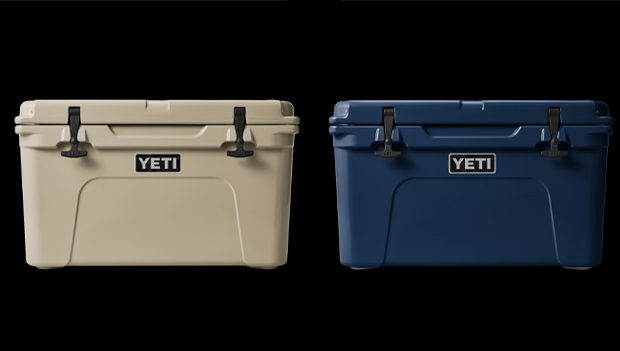
What We Like
- It's built with up to 3 inches of Permafrost™ insulation
- It features durable rotomolded exterior construction
- It comes with a basket to hold dry goods up and out of melting ice
- You get tie-down slots for attaching to your boat, trailer, or truck
- The durable carry handles are made from military-grade rope
What We Don't Like
- The price can make you pause
- It holds less than the RTIC cooler
BUY: Yeti Tundra 45
RTIC 45
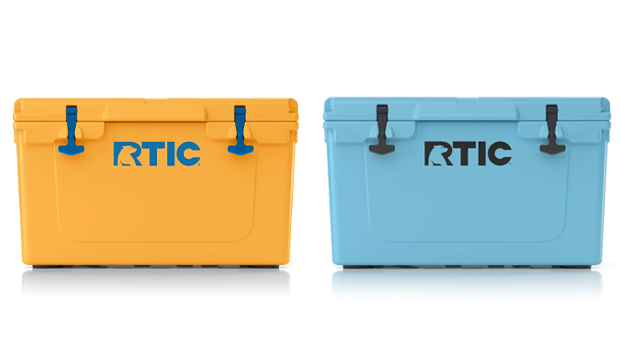
What We Like
- It's cheaper than the Yeti Cooler
- It boasts similar durable rotomolded exterior construction as the Yeti
- The molded tie-down slots make it easy to secure on a moving vehicle or vessel
- It has those awesome 3" foam insulated walls
- It has drain holes on both ends for fast draining and easy cleaning
What We Don't Like
- It doesn't come with a basket for dry goods
- It's heavier than the Yeti cooler
BUY: RTIC 45
Hard Cooler Comparison
For starters, these 45-quart coolers are nearly identical when it comes to their exterior dimensions. Here's a quick breakdown:
- Yeti Tundra 45: 25.8"W x 16.1"D x 15.4"H
- RTIC 45: 26.5"W x 16.5"D x 15.9"H
The Yeti cooler actually comes in 6 pounds lighter than the RTIC when they're both empty, which may not seem like a lot, but it makes a difference when you're loading and unloading from a truck bed.
In terms of capacity, the Yeti claims to hold up to 28 beer cans (if using a 2-to-1 beer-to-ice ratio) and 34 pounds of ice if filling it with ice only. In comparison, the RTIC claims to hold up to 36 beer cans or 40 pounds of ice (or 45 quarts of water if you needed it to for some strange reason).
The last feature that might get easily overlooked is the fact that the Yeti comes with a dry goods basket and the RTIC does not. This may seem insignificant, but it will save you from fishing soggy foods out of the bottom of your cooler once your ice is melted.
Soft Coolers
Yeti Hopper Flip 18

What We Like
- The wide zippered opening provides easy access to food and beverages
- It boasts a durable, leakproof zipper (they claim 100% leakproof!)
- The Hitchpoint™ grid on the front of the cooler allows you to attach a bottle opener and other accessories
- It's made with high-density shell fabric that's puncture, UV, and even mildew resistant
- The interior features closed-cell foam insulation
What We Don't Like
- It's nearly as expensive as the 45-quart Yeti cooler despite having less than half the capacity
- It doesn't have any drain openings
BUY: Yeti Hopper Flip 18
RTIC Soft Pack Cooler
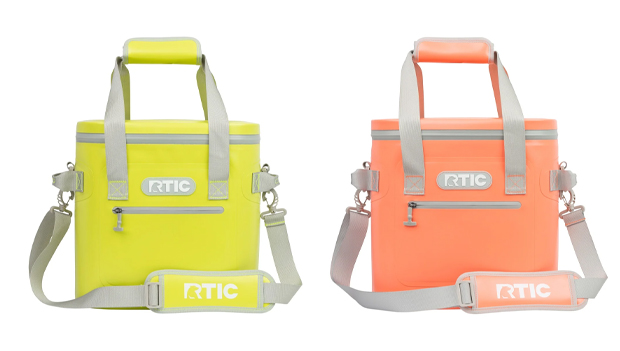
What We Like
- It's less than half the price of the Yeti cooler
- It uses 2" of closed-cell foam insulation
- It features a puncture and tear-resistant interior liner
- It floats, which is great for your river or SUP trips
- The exterior is finished with a water-resistant nylon shell
What We Don't Like
- You won't have the ability to drain water with food or beverages still inside
- It offers smaller interior dimensions than the Hopper Flip 18
Soft Cooler Comparison
For the sake of consistency, let's start again with a quick comparison of these soft cooler's exterior dimensions:
- Yeti Hopper Flip 18: 16.3"W x 10.8"D x 13"H
- RTIC Soft Pack Cooler: 13.5"W x 9.5"D x 13.75"H
As you can see, the RTIC cooler is slightly more compact and it also weighs a little more than 2 pounds less than the Flip 18. But when it comes to carrying capacity, they are both designed to hold up to 20 cans or approximately 24 pounds of ice.
The real comparison here is the price. The RTIC cooler is roughly one-third of the total cost of the YETI Hopper Flip 18. But it should be noted that RTIC offers 12-can, 30-can, and 40-can versions of their soft pack coolers, which all vary in price, dimensions, and carrying capacity.
If you're looking at style, it's also important to note the five color options for the Flip 18 while RTIC gives you 11 choices. Just be aware that the color choices for the RTIC soft pack coolers will vary depending on the cooler size you choose.
Drinkware
Yeti Rambler

What We Like
- You get the ability to customize your own color
- You can choose from multiple size options
- It's compatible with most cup holders
- It's made with puncture and rust-resistant stainless steel
- It's dishwasher safe
What We Don't Like
- The price, while still very affordable, is roughly double that of the RTIC can cooler
- Yeti sells replacement gaskets, but not replacements if you lose only the bottom section
BUY: Yeti Rambler
RTIC Can Cooler
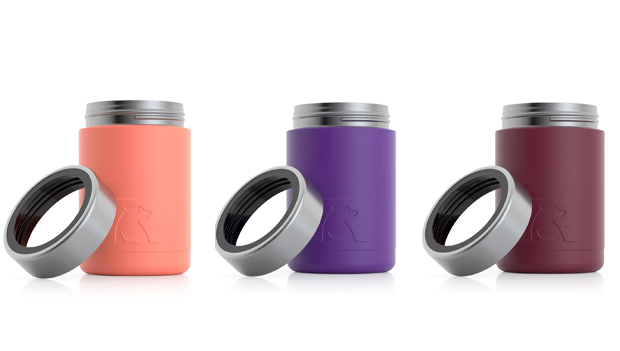
What We Like
- The price is roughly half of what you'd pay for the Yeti Rambler
- You can buy these in bulk (up to cases of 48)
- It boasts double wall vacuum insulation for keeping your beverages cold without getting your hands cold
- It features a similar durable stainless steel construction as the Yeti Rambler
- The no-sweat exterior prevents condensation
What We Don't Like
- You only get to choose from three color options
- It's only made for standard 12 oz. can size (but RTIC does have other products for different can sizes)
BUY: RTIC Can Cooler
Drinkware Comparison
Once again, we'll begin with a quick synopsis of the exterior dimensions of these can coolers:
- Yeti Rambler: 3.1"W x 4.9"H
- RTIC Can Cooler: 3"W x 5"H
So they are basically identical in size and also both weigh roughly half a pound. They also feature strikingly similar construction when it comes to the insulation, stainless-steel material, and sweat-resistant exteriors.
Aside from the Yeti Rambler being nearly double the price, the main differences I notice lie in your size and color customization options. Yeti offers 12-ounce slim and 16-ounce versions of the Rambler, but RTIC actually does, too (they're just listed as entirely different products).
However, Yeti does have the advantage in offering many more color options and giving you the ability to customize your Rambler. So if you're looking to be the only one with a Rambler like yours, then Yeti gets the leg-up here.
About Yeti
Yeti was founded in 2006 and it has grown into one of the most recognizable cooler brands in the world since. Their stated mission is to "build the cooler you'd use every day if it existed." Well, they've brought excellent coolers into existence and forced many of their competitors to do the same.
Started by two brothers, Yeti offers excellent product quality and a wide array of outdoor products. According to Flip Pallot, a legendary angler and Yeti Fishing Ambassador, "Yeti represents the yardstick by which all other outdoor products are measured."
About RTIC
RTIC's motto is "Overbuilt. Not Overpriced." This tells you a lot of what you need to know about this company. Launched in 2015, RTIC quickly became one of Yeti's most direct competitors with their ability to bring similar bomber coolers to market at a more affordable price point.
The company is based in Houston, Texas, but they have five warehouses across the country in California, Illinois, Texas, Georgia, and Pennsylvania. As a direct-to-consumer retailer, they're the brand, importer, marketing team, and shop all rolled into one, meaning they can get you high-end products for less than their competitors.
FAQs About RTIC vs. Yeti
Are RTIC and Yeti owned by brothers?
Funny enough, they are both owned by an entrepreneurial set of brothers—just not the same ones. RTIC is owned by twins John and Jim Jacobsen while Yeti was founded by brothers Roy and Ryan Seiders.
Are Yeti coolers worth it?
After combing through user reviews, it's hard to find too many people who are unhappy with the performance of their hard-sided Yeti cooler. Their soft-sided coolers get a little more negative reviews than their other products, however.
Once you wrap your mind around the price, Yeti coolers are definitely worth it. Plus, you'll need to consider the reality that a Yeti might be the last cooler you ever need to invest in if you treat it right.
Is RTIC as good as Yeti?
When you really dive into things like the amount and type of insulation, the design of the cooler's plastic exterior, the placement of drain holes, the quality of carry handles, the inclusion of tie-down points, and a host of other features, it's hard to tell RTIC and Yeti apart.
If you took the brand logos off each of their 45-quart coolers and compared them side-by-side, you'd have a tough time telling them apart. So, yes, RTIC coolers are designed to perform just as well as Yeti coolers and their user reviews seem to bear that out.
Plus, you'll need to consider the reality that you can usually pick up an RTIC cooler for anywhere from 30 to 70 percent less than what you'd pay for a similarly-sized Yeti cooler.
Which brand was started first: RTIC or Yeti?
Yeti gets the nod here, as they began in 2006 and RTIC didn't come along until nearly a decade later in 2016. Interestingly enough, both of these companies can trace their roots back to central and southern Texas, as Yeti was started in the Austin area and RTIC is based in Houston.


